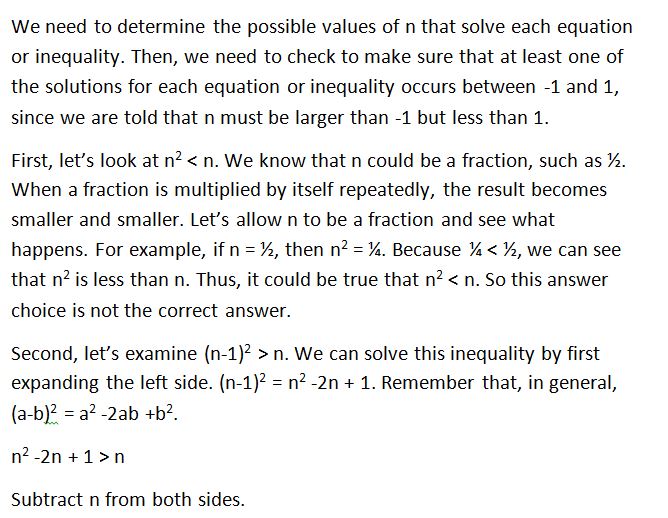All PSAT Math Resources
Example Questions
Example Question #131 : Equations / Inequalities
If –1 < w < 1, all of the following must also be greater than –1 and less than 1 EXCEPT for which choice?
|w|
w2
w/2
3w/2
|w|0.5
3w/2
3w/2 will become greater than 1 as soon as w is greater than two thirds. It will likewise become less than –1 as soon as w is less than negative two thirds. All the other options always return values between –1 and 1.
Example Question #21 : Inequalities
Solve for .
Absolute value problems always have two sides: one positive and one negative.
First, take the problem as is and drop the absolute value signs for the positive side: z – 3 ≥ 5. When the original inequality is multiplied by –1 we get z – 3 ≤ –5.
Solve each inequality separately to get z ≤ –2 or z ≥ 8 (the inequality sign flips when multiplying or dividing by a negative number).
We can verify the solution by substituting in 0 for z to see if we get a true or false statement. Since –3 ≥ 5 is always false we know we want the two outside inequalities, rather than their intersection.
Example Question #256 : New Sat
If and , then which of the following could be the value of ?
To solve this problem, add the two equations together:
The only answer choice that satisfies this equation is 0, because 0 is less than 4.
Example Question #1 : How To Find The Solution To An Inequality With Addition
If , which of the following could be a value of ?
-
In order to solve this inequality, you must isolate on one side of the equation.
Therefore, the only option that solves the inequality is .
Example Question #22 : Inequalities
What values of make the statement true?
First, solve the inequality :
Since we are dealing with absolute value, must also be true; therefore:
Example Question #151 : Algebra
If –1 < n < 1, all of the following could be true EXCEPT:
(n-1)2 > n
16n2 - 1 = 0
n2 < n
n2 < 2n
|n2 - 1| > 1
|n2 - 1| > 1
Example Question #166 : Equations / Inequalities
(√(8) / -x ) < 2. Which of the following values could be x?
-1
-3
-2
-4
All of the answers choices are valid.
-1
The equation simplifies to x > -1.41. -1 is the answer.
Example Question #31 : Inequalities
Solve for x
Example Question #151 : Algebra
We have , find the solution set for this inequality.
Example Question #32 : Inequalities
Fill in the circle with either , , or symbols:
for .
The rational expression is undefined.
None of the other answers are correct.
Let us simplify the second expression. We know that:
So we can cancel out as follows:
All PSAT Math Resources



















































































